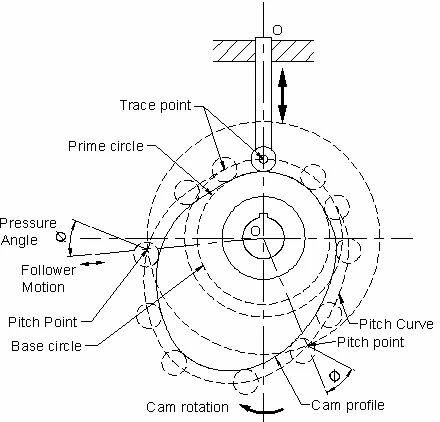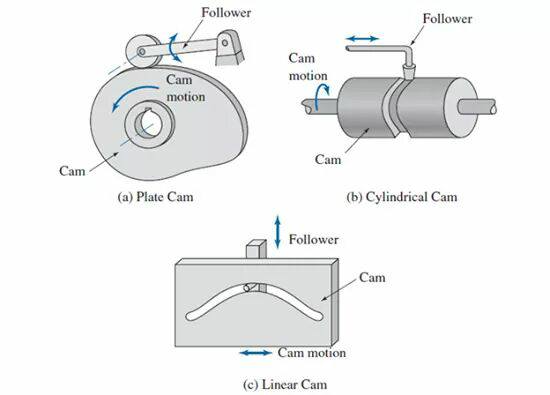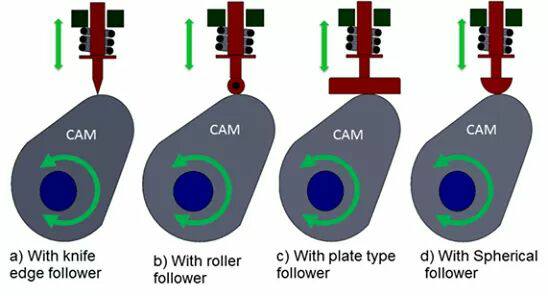DEFINITION
Cam is a mechanical element used to transmit reciprocating or oscillating motion to another machine element known as follower. Cam and follower is a type of assembly, both work together on any element of the machine. Cam and followers are the example of a higher pair due to the line contact between them. Some complicated movements are easily achieved using cams and followers that are difficult to achieve. We can say that the cam and followers are the most important part of the mechanisms. Cam and follower combination is mainly used in internal combustion engines to operate intake and exhaust valves, machine tools, press control mechanisms, etc. They are usually manufactured by die casting, milling and punching.
A cam is a rotating or sliding part in a mechanical linkage that drives a mating component known as a follower. From a functional standpoint, a cam and follower arrangement is very similar to linkages. The cam accepts an input motion (rotary motion or linear motion) and transmits a resultant motion (linear motion or rotary motion) to a follower.
caption-attachment-10068″ >  camera nomenclature
camera nomenclature
CLASSIFICATION OF CAMS AND FOLLOWERS
CAMS CLASSIFICATION
The camera types are as follows.
A. According to the cam shape
In this category, cam types are classified by cam shape and profile. They are as follows.
1. Radial or disc cam
In radial cam, the cam profile (cam shape) is designed so that the follower moves according to the cam shape or cam profile in the direction perpendicular to the cam axis. There is always surface contact between the cam profile and the follower due to spring or gravity force.
2. Cylindrical cam
In cylindrical cam, the follower axis and the cam axis are parallel to each other. Cylindrical cam is a cylindrical shaft in which the profile is made on the cylindrical surface by machining. This profile has the shape of a groove and the follower has superficial contact with this groove. As the cylindrical shaft or cylindrical cam rotates, the follower motion and follower motion may be reciprocating or oscillating.
3. Translation or wedge camera
In this type of cam, the cam is reciprocated and this movement is used to move the follower. Cam has a specific shape or profile by which the follower movement is made.
4. Combined camera
In this type, two discs are connected together and the axes of the discs are offset by the distance, to form the cam profile. The follower has surface contact with the cam profile by two rollers. As the cam rotates the follower, follow it.
5. Globooidal camera
The globoidal cam is an axis and has a concave or convex circumference. In which the groove is made by machining and this groove is used to give movement to the follower. Globoid cam is used to oscillate the follower around a fixed point.
6. Spherical Cam
The spherical cam has the spherical shape in which the groove is made. The follower has surface contact with this groove. As the cam rotates, the follower oscillates about a fixed point.
B. According to the follower's movement
In this category, cam types are classified according to the movement of the follower. Follower movement depends on the cam profile for this; Cams are also classified according to follower movement.
1. Dwell Rise Dwell Return Dwell cam
In this type, the movement of the follower is considered. According to the name, the movement of the follower is done in a way that it first remains, then rises again, remains, then returns and again remains. This entire process is done in one rotation (360 degrees) of the cam.
2. Stay Climb Return Dwell Camera
In this type, the movement of the follower is considered. In keeping with the name, the movement of the follower is done in a way that it first remains, then rises, then returns and remains again. This entire process is done in one rotation (360 degrees) of the cam.
3. Ascent Return Ascension Camera
In this type, the movement of the follower is considered. As per the name, the movement of the follower is done in such a way that it first goes up and then returns. This entire process is done in one rotation (360 degrees) of the cam.
4. Live Rise Live Camera
In this type, the movement of the follower is considered. As per the name, the follower movement is done in a way that it first remains, then rises, and then remains again. This entire process is done in one rotation (360 degrees) of the cam. And in 360 degrees it suddenly drops to its first position.
C. According to the type of follower restriction
For the cam and follower mechanism to function properly, it is important to maintain surface contact between the cam profile and the follower at all times of rotation and at any speed. For this need, spring force, gravity force or positive drives are used in cam and follower mechanisms. Based on this, cams are classified by follower restriction type and are as follows.
1. Preloaded spring cam
In this type of cam, spring force is used. The compression spring is preloaded into the follower so that it maintains contact with the surface at all times.
2. Positive drive cam
This type of cam does not require any external force. The follower is designed in such a way that it does not require any external force.
 camera types
camera typesFOLLOWER CLASSIFICATION
The types of followers are as follows.
A. According to the surface in contact
Followers are classified by the surface contact between the cam and follower, generally included in this group. There are different types of surface contact between cam and follower and according to the surface contact they are classified as follows.
1. Knife Edge Follower
According to the name, the knife follower has a knife edge, and the knife edge has a contact surface with the cam profile (the cam profile is a cam shape). As the follower has a knife edge, there is more wear between the follower and the cam profile. Due to wear, the cam profile changes over time and does not function properly. This is the reason why the knife edge is not used in practice.
2. Roller Follower
According to the name, roller follower has roller contact and surface between cam and follower is bearing contact. Reduces cam profile wear.
3. Flat Follower
The flat follower has a flat profile on the contact surface between the cam and the follower. It is useful where space is limited. The flat follower is used in automobile engines where space is limited.
4. Spherical follower
In the flat-faced follower, stresses are produced. To reduce these stresses, the flat face is machined into a spherical shape called a spherical follower.
 follower types
follower typesB. According to the follower's movement type
In this category, followers are classified by the relative motion and movement between the cam and the follower, as follows.
1. Translatory motion type follower
In this type of follower, the follower has translational motion, which means the cam is rotating and the follower switches between guides. Examples of this type of follower are the knife-edge follower, the roller follower, the flat follower and the spherical follower.
2. Oscillatory movement type follower
In this type of follower, the follower has oscillating movement. The cam rotates and, depending on the profile of the cam, the follower also moves, but the follower is fixed at the point around which the follower oscillates. This type of tracker is called oscillatory motion type tracker.
C. According to the follower's movement line
In this category, followers are classified by the follower axis line and are as follows.
1. Radial follower
In radial follower, the follower axis and the center of the cam are in one line or the follower axis passing through the center of the cam is called radial follower. Examples of this type of follower are the knife-edge follower, the roller follower, the flat follower and the spherical follower.
2. Displacement Follower
In offset follower, the axis of movement of the follower is displaced from the center of the cam around which the rotation of the cam is known as offset follower.

























































